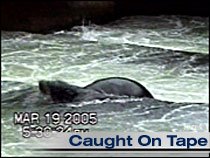
I don't know if this is the same Sea Lion as C404 in the story below, but you get the idea. This photo came from this article titled "Daring sea lion makes a run up a fish ladder"
Here's a more recent article:
Crafty Sea Lion Befuddles Fish Biologists
By JOSEPH B. FRAZIER, Associated Press Writer
CASCADE LOCKS, Ore. - In his way, C404 is kind of cute, with those sea-lion whiskers, soft brown eyes and furry little head. But to many he is a sea lion either from hell — or from Harvard.
C404 has driven the U.S. Army Corps of Engineers at Bonneville Dam to near distraction as he and his ilk sit at the base and munch salmon gathered to continue upriver to spawn.
Numerous sea lions head for the dam each spring, but C404 is in a class by himself.
He has figured out how to get into fish ladders that help fish past the dam — where endangered salmon and other fish become his easy prey.
The engineers have used everything legal to get rid of the California sea lion, who may weigh 1,000 pounds or more. They have installed grated exclusion gates and tried huge firecackers, rockets, rubber bullets, and noises sea lions don't like.
But C404 has given them the flipper.
He and a handful of cohorts already are waiting for the spring run of chinook salmon, which starts in earnest in April.
Then C404, named because of a brand applied by a state and federal program, will personify a larger problem, as 100 or more of his buddies join him.
Last year they ate about 3.5 percent of the migrating run at a time when salmon numbers were down and demand was up. This year's commercial salmon season may be cancelled because of river problems elsewhere. The loss percentage is climbing.
Robert Stansell, a fish biologist at Bonneville with the Corps of Engineers, knows the lively and alert C404 all too well.
"If he were in a litter of puppies, he's the one you would pick," he said.
He said C404 has been showing up each year since at least 2003 and has learned to rub it in. Last year he appeared in a window where fish counters keep track of salmon migrating upstream. The data helps predict the size of future runs.
"He even rolled over a little so we could get a look at his brand," Stansell said.
Other marine mammals haven't learned to pull that trick off.
Continue Reading This Article









